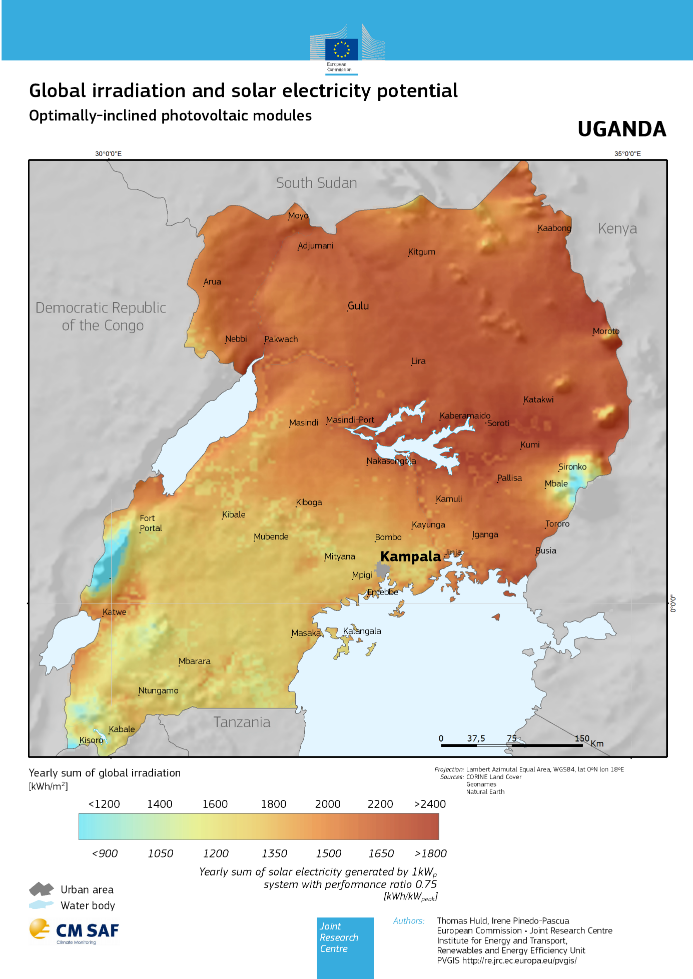A high percentage of Uganda’s energy consumption comes from renewable sources, but mainly from traditional firewood and charcoal. Modern renewables accounted for only 22% in 2020. So, a rapid transition towards renewable energy, and bioenergy in particular, is needed to avoid further deforestation, emissions, and health risks. Sarah Helen Rüdenauer reports.

Credits: Sarah Helen Rüdenauer (All Rights Reserved).
Uganda is a landlocked country in East Africa bordered by Kenya, South Sudan, the Democratic Republic of Congo, Rwanda, and Tanzania. The country has a population of about 45.9 million people.
Uganda boasts bountiful natural resources, such as the vast waters of the River Nile and part of Lake Vitoria, the country’s high solar radiation, and its flora and fauna. The Nile originates from Jinja, a city in the southeast of the country, and forms one of the country’s largest hydroelectric resources.
In most parts of the world, Uganda is known for tourism to its forests, grasslands, and wildlife reserves. In addition, agriculture is important to the Ugandan economy, thanks to its high altitude, soil types, and predominantly equatorial warm and humid climate. The Ministry of Agriculture, Animal Industry and Fisheries states that the economy is dependent on agriculture, with over 60% of Uganda’s workforce employed in the agricultural sector which produces 23.8% share of GDP. Until now, agricultural work is mostly done by manual labour in small scale farms with only a few hectares. Energy and fuel run machinery is still unavailable to the majority of farmers.
Also, food security is a challenge and according to the World Bank, 41.4% of Uganda’s population lives in poverty on less than $2.15 per day. Socio-economic development, poverty reduction and food security hinge on a sustainable and reliable energy supply.
A closer look at the energy sector
In 2020, 42% of Uganda’s population had access to electricity and 5% had access to clean cooking. According to Uganda’s Ministry of Energy and Mineral Development (MEMD), electricity consumption is accountable for only 2% of the primary energy demand. Hydropower is the main source of electricity generation with a total capacity of 84%.
The accessibility of electricity varies sharply between rural and urban areas – and only 8% of the rural population had access to the power grid in 2019. Total installed power generation capacity reached 1.3 GW in 2021, compared to Germany’s installed capacity of 229 GW in the same year. In June 2019, per capita electricity consumption in Uganda was only 75 kWh/a, while in Germany it is 6787 kWh/a.
While a high percentage of 92% renewable energy in Uganda’s total energy supply seems astounding, the figure is a bit more complicated than it appears at first glance.
Out of its total energy supply, 92% is derived from renewable sources, with 98% coming from bioenergy. To illustrate, only 2% of renewable energy consumption is allocated to electricity generation, while a staggering 98% is utilized as bioenergy, primarily for cooking purposes. This indicates a disproportionate emphasis on bioenergy as the primary source of renewable energy, with cooking being the predominant application.
The high demand for biomass leads to deforestation, in 2013 the demand was at 53 million tonnes while the annual supply remained at just 26 million tonnes.
The fact that only 5% of the population has access to clean cooking facilities, cast these numbers in a less positive light.
To summarize: A high percentage of Uganda’s energy consumption comes from renewable sources, but mainly from traditional firewood and charcoal. Modern renewables accounted for only 22% in 2020. So, a rapid transition towards renewable energy, and bioenergy in particular, is needed to avoid further deforestation, emissions, and health risks.
How can modern energy access and especially access to electricity and clean cooking increase?
One step towards energy justice and a very crucial way to start is through policy and awareness. The Ugandan Government committed to several energy policies over the years, with one of the most significant being the Sustainable Energy for All (SEforALL) Initiative. SE4ALL is an initiative by the United Nations (UN) Secretary General towards the achievement of Sustainable Development Goal 7 (SDG7) – access to affordable, reliable, sustainable and modern energy for all by 2030.
The SE4ALL Action Agenda redefined Uganda’s overall energy goals by 2030 as:
- an electrification rate of over 98%,
- access to modern cooking solutions of over 99%,
- the reduction of national wood consumption by 40%
- the improvement of energy efficiency of power users by min. 20%
- a share of renewable energy in the total final energy consumption to be over 90% in electrical energy
- a share of renewable energy of at least 36% in thermal energy consumption
These ambitious goals can only be reached with a diverse energy mix, including as many different renewable energy sources as possible. The desired energy mix is, of course, highly dependent on the renewable energy potential available in Uganda. The table below gives an overview of these potentials.
| Energy Source | Hydro (MW) |
Small hydro (MW) |
Solar thermal (TWh/y) | Solar PV (TWh/y) | Wind (CF 20%) (TWh/y) |
Wind (CF 30%) (TWh/y) |
Wind (CF 40%) (TWh/y) |
Geothermal (MW) |
| Potential | >4500 | 200 | 8582 | 9470 | 815 | 100.7 | 23.8 | 450 |
| Utilized | 45% | 17% | >0.1% | >0.1% | ||||
Table source: European Union, Joint Research Centre (JRC), 2019

Figure 1: Global irradiation and solar electricity potential in Uganda Source: @European Commission PVGIS
Although Uganda’s power generation focuses on hydropower, its potential is not yet exploited. There are still great opportunities for hydro and solar energy. Figure 1 shows Uganda’s yearly global irradiation, the total solar radiation incident on a horizontal surface, which reaches at least 1600 kWh/m² nearly all over Uganda and in many parts of the country even above 2000 kWh/m². Solar energy-based off-grid solutions could provide access to sustainable energy in rural and remote areas. Certainly, the potential for renewable energy in Uganda is extremely high, but the big question remains about where the investments will come from.
The Government of Uganda has already recognized the importance of addressing climate change and has implemented policies in this regard, for example Uganda’s Sustainable Energy for All (SE4All) Initiative Action Agenda. However, there is a need for further measures, strategies, and investments, particularly concerning the use of biomass. To ensure a sustainable energy supply for all Ugandans, it is crucial to diversify the energy mix. This can be achieved through the adoption of decentralized and grid-connected renewable energy solutions. The government should promote the development and deployment of renewable energy technologies, such as solar, wind, hydro, and geothermal power. Additionally, decentralized energy solutions, such as off-grid solar systems, mini-grids, and small-scale hydroelectric projects, should be prioritized to ensure access to clean energy in remote areas. Strengthening the grid infrastructure is also necessary to support the integration of renewable energy sources and improve overall energy access and reliability. Only then, will the country begin to live up to its potential.